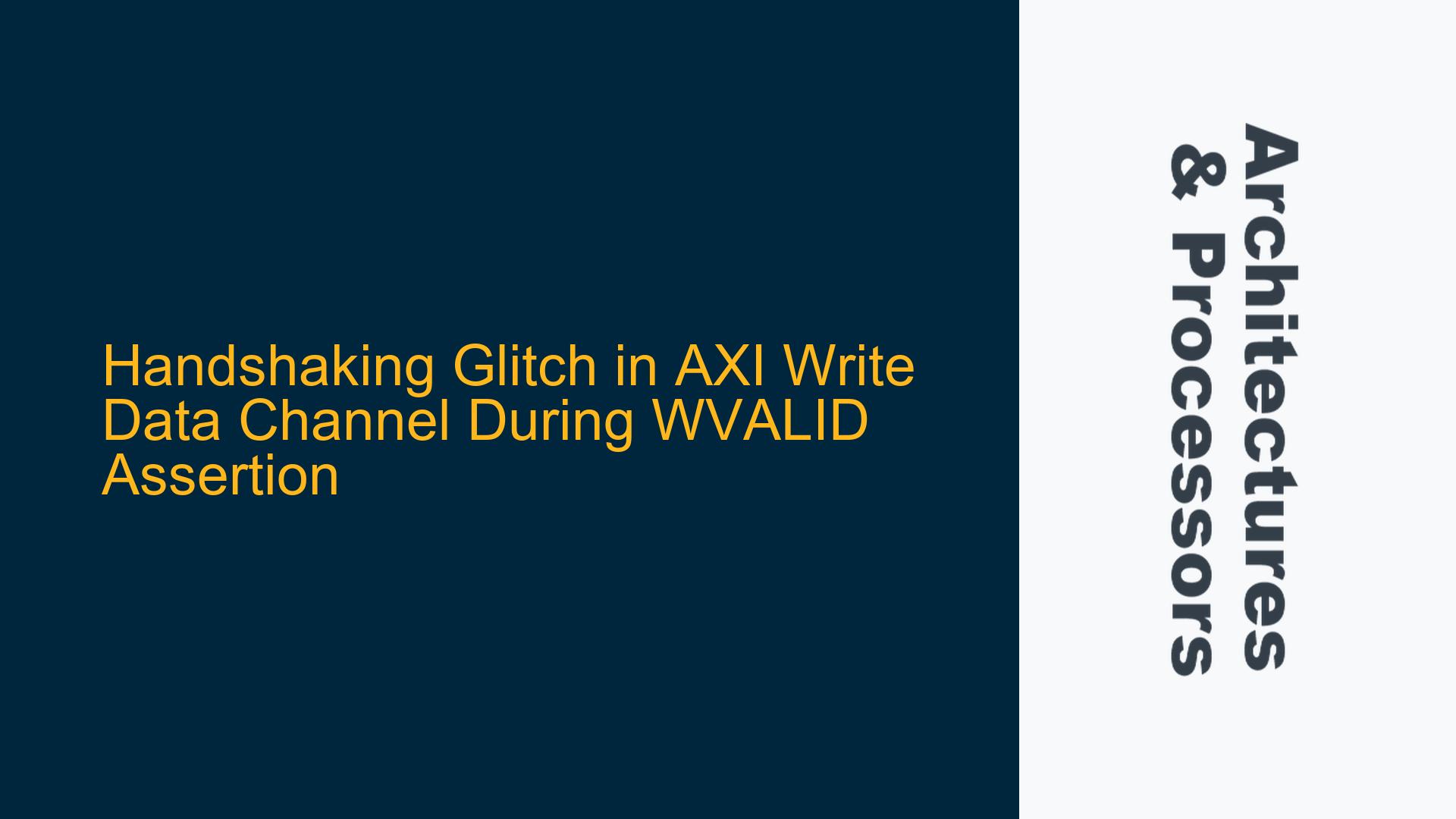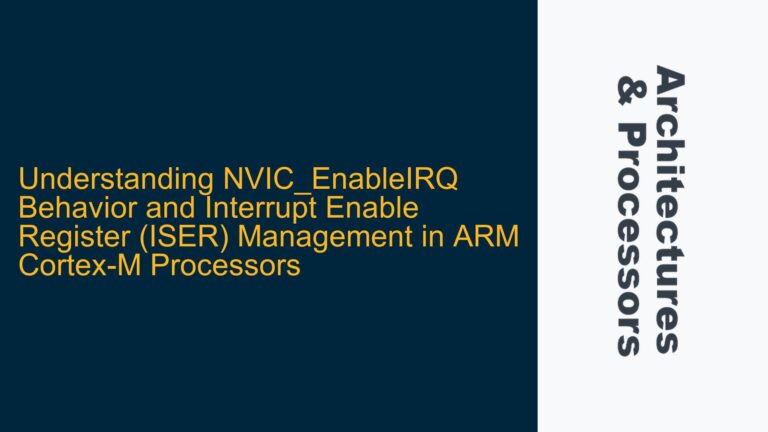WVALID Assertion Timing and Glitch During AXI Write Data Handshake
The issue revolves around the assertion of the WVALID signal in the AXI (Advanced eXtensible Interface) write data channel during a handshake between the master and slave. Specifically, the problem occurs when the master attempts to assert WVALID in the same ACLK cycle where the previous transfer completes, as indicated by the deassertion of WVALID due to the detection of WREADY from the slave. The waveforms provided in the discussion show a glitch following the ACLK rising edge, which occurs when the master transitions from waiting for WREADY to initiating a new transfer. This glitch is a result of the control logic switching states, and it raises concerns about the timing and stability of the WVALID signal during this critical phase.
The AXI protocol mandates that the WVALID signal must remain stable until the handshake is complete, as indicated by the assertion of WREADY. However, the glitch observed suggests that the control logic for WVALID is not handling the state transition smoothly, leading to a potential violation of the protocol’s timing requirements. This issue is particularly critical in high-performance systems where back-to-back data transfers are common, and any delay or instability in the handshake process can lead to data corruption or loss.
The core of the problem lies in the synchronization between the master and slave during the write data handshake. The master must ensure that WVALID is asserted at the correct time to maintain protocol compliance while avoiding any glitches that could disrupt the handshake process. This requires a deep understanding of the AXI protocol’s timing requirements and the implementation of robust control logic to handle state transitions seamlessly.
Control Logic State Transition and Synchronization Issues
The primary cause of the glitch in the WVALID signal is the improper handling of state transitions in the control logic of the AXI master. When the master detects WREADY high on the rising edge of ACLK, it signifies the completion of the current write data transfer. At this point, the control logic must transition from the state where it was waiting for WREADY to the state where it initiates the next transfer. During this transition, WVALID is supposed to remain high to indicate that the next data transfer is ready to begin. However, the observed glitch suggests that the control logic is not handling this transition smoothly.
One possible cause of this issue is the lack of proper synchronization between the state machine controlling WVALID and the ACLK signal. If the state machine is not properly synchronized with the clock, it can lead to metastability issues, causing the glitch observed in the waveform. Additionally, the control logic may not be accounting for the propagation delays within the state machine itself, leading to a brief period where WVALID is neither fully asserted nor deasserted, resulting in the glitch.
Another potential cause is the improper handling of the WREADY signal by the master. The AXI protocol requires that WREADY can be asserted by the slave at any time, and the master must be able to respond to it immediately. If the master’s control logic is not designed to handle this asynchronous nature of WREADY, it can lead to timing violations and glitches in the WVALID signal. This is particularly problematic in systems where the slave may have variable latency in asserting WREADY, requiring the master to be highly responsive to changes in the WREADY signal.
Furthermore, the issue could be exacerbated by the use of non-optimal synthesis constraints during the implementation of the AXI master. If the synthesis tool is not provided with the correct timing constraints, it may not optimize the control logic for the required timing, leading to potential glitches and timing violations. This is especially critical in high-speed designs where the margin for error is minimal, and any deviation from the expected timing can lead to functional failures.
Implementing Robust Control Logic and Timing Fixes
To address the glitch in the WVALID signal, several steps can be taken to ensure that the control logic handles state transitions smoothly and maintains protocol compliance. The first step is to review and optimize the state machine controlling WVALID. The state machine should be designed to handle the transition from waiting for WREADY to initiating the next transfer without any intermediate states that could cause a glitch. This can be achieved by ensuring that the state machine is fully synchronous with the ACLK signal and that all state transitions occur on the rising edge of the clock.
Additionally, the control logic should be designed to account for the asynchronous nature of the WREADY signal. This can be achieved by implementing a synchronization mechanism that ensures the master responds to WREADY immediately, without any delay. One approach is to use a flip-flop-based synchronizer that captures the WREADY signal on the rising edge of ACLK and uses it to trigger the state transition in the control logic. This ensures that the master is always in sync with the slave and can respond to changes in WREADY without any delay.
Another important step is to review and optimize the synthesis constraints used during the implementation of the AXI master. The synthesis tool should be provided with the correct timing constraints to ensure that the control logic is optimized for the required timing. This includes setting up proper clock constraints, input/output delays, and false paths to ensure that the control logic meets the timing requirements of the AXI protocol. Additionally, the synthesis tool should be instructed to prioritize the optimization of the control logic to minimize any potential glitches and timing violations.
In addition to optimizing the control logic, it is also important to verify the design thoroughly to ensure that the glitch in the WVALID signal is eliminated. This can be achieved by running extensive simulation tests that cover all possible scenarios, including back-to-back data transfers, variable latency in WREADY, and different clock frequencies. The simulation should include both functional and timing checks to ensure that the design meets the requirements of the AXI protocol and that there are no timing violations or glitches in the WVALID signal.
Finally, it is recommended to use formal verification techniques to verify the correctness of the control logic. Formal verification can be used to prove that the control logic meets the requirements of the AXI protocol and that there are no deadlocks, livelocks, or other issues that could lead to glitches in the WVALID signal. This can be particularly useful in complex designs where traditional simulation-based verification may not be sufficient to cover all possible corner cases.
In conclusion, the glitch in the WVALID signal during the AXI write data handshake is a critical issue that can lead to data corruption or loss if not addressed properly. By optimizing the control logic, implementing proper synchronization mechanisms, and using robust verification techniques, it is possible to eliminate the glitch and ensure that the design meets the requirements of the AXI protocol. This will result in a more reliable and high-performance AXI master that can handle back-to-back data transfers without any issues.






